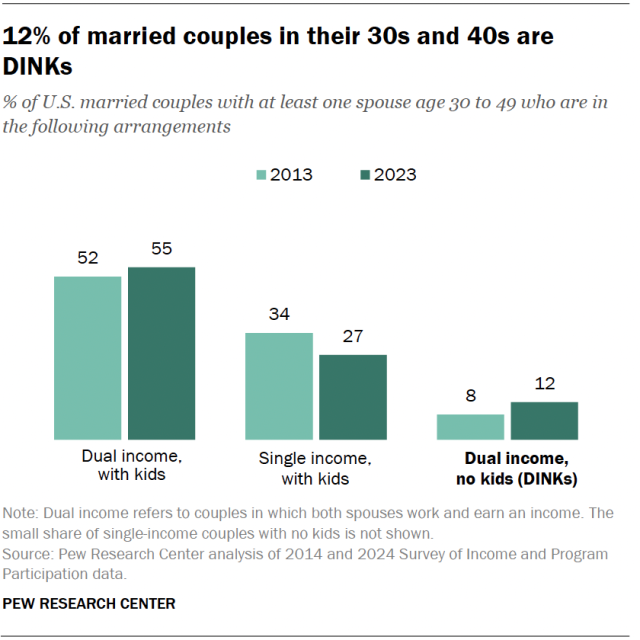
In the United States, 12% of married couples with at least one spouse in their 30s or 40s have two incomes and no kids, according to a Pew Research Center analysis of federal data.

This group, often referred to as “DINKs,” has grown slightly over the past decade. In 2013, 8% of married couples in the same age range were DINKs.
The share of dual-income couples with kids has also inched up slightly since 2013, while the share of single-income couples with kids has decreased from 34% to 27%.
DINKs have gained attention in recent years as videos showcasing their lifestyle have gone viral on social media. But there’s no official definition of who’s included in this group. This analysis defines DINKs as married couples in which at least one spouse is 30 to 49 years old and:
- Both spouses work and earn an income
- Neither spouse has ever had any children
We chose this age range to capture couples who are older than the average age at first birth for women, which was 27.5 in 2023. We also chose to focus on married couples because they are more likely than cohabiting couples to pool their finances.
Other analyses of DINKs might use a different age range or focus on cohabiting couples in addition to married couples. It’s also important to note that some couples who are defined as DINKs in this analysis still may have children in the future.
The remainder of this analysis examines how DINKs compare with dual-income couples with kids, based on available federal data. It is part of our broader research into how the American family is changing.
Related: The Experiences of U.S. Adults Who Don’t Have Children
How do DINKs compare with dual-income couples with kids?
DINKs tend to be younger than dual-income couples with kids:
- The median age of the older spouse in DINK couples is 36 as of 2023. By comparison, among dual-income couples with kids, the median age of the older spouse is 43.
DINKs are also more likely than dual-income couples with kids to be college graduates and to work full time:
- In 58% of DINK couples, both spouses have at least a bachelor’s degree. The corresponding figure among dual-income couples with kids is 43%.
- In 81% of DINK couples, both spouses are employed full time. This is the case in 68% of dual-income couples with kids.

When it comes to financial outcomes, DINKs tend to have higher household incomes but less wealth than dual-income couples with kids:
- Median household income among DINKs is $193,900 as of 2023, compared with $151,900 among dual-income couples with kids.
- Median wealth for DINKs is $214,700, compared with $361,500 among dual-income couples with kids.

So why might DINKs have less wealth than dual-income couples with kids? One important reason is that DINKs are less likely to own a home – the primary source of wealth for many Americans. Some 71% of DINKs own a home, compared with 79% of dual-income couples with kids. And among homeowners, DINKs have less home equity than dual-income couples with kids ($165,000 vs. $222,000 as of 2023).
Age also plays a role when it comes to wealth: People tend to accumulate more wealth as they grow older. DINKs are younger than their counterparts in the same age group who do have children.
